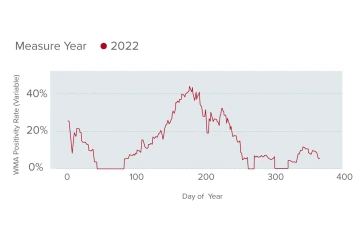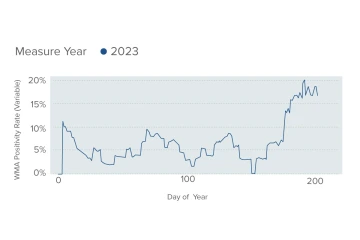Urgent Care data show Valley fever season has begun in Arizona
To increase the chances of receiving proper care, people with symptoms of pneumonia should ask to be tested for Valley fever.

Studying Valley fever trends over several years, a team at the Valley Fever Center for Excellence at the University of Arizona College of Medicine – Tucson has created a forecasting tool to determine when the illness is spiking in the community. Data for July indicate that Arizona is now in a Valley fever season.
“Right now, if you’re diagnosed with pneumonia, there is about a 1 in 5 chance that your pneumonia is caused by Valley fever,” said John Galgiani, MD, director of the Valley Fever Center for Excellence. “If you live in Arizona and you get pneumonia, you should be tested for Valley fever.”
Valley fever, medically known as coccidioidomycosis, is a fungal infection native to the Sonoran Desert and other parts of the western United States. Half of all U.S. Valley fever infections occur in the Phoenix metropolitan area. Unfortunately, there is low awareness of Valley fever, and health care providers often miss the diagnosis.

Figure 1. Using a 30-day moving average, this graph shows the percentage of pneumonia that is due to Valley fever in Banner’s Arizona urgent care clinics in 2022. Once that average reached 20%, the rates remained elevated for months.
In response, Dr. Galgiani has been working with Banner Health to increase Valley fever testing for pneumonia patients in Banner’s 44 urgent care clinics in Arizona, most of which are in Maricopa County. Through that partnership, the Valley Fever Center for Excellence and Banner are analyzing Valley fever diagnoses in real time.
“What these data are showing is that we are in a Valley fever season right now and likely will stay that way for some time,” Dr. Galgiani said. “We have been seeing high rates of Valley fever for the past month. Previously, this trendline has shown that it tends to stay elevated for some period of time.”
For the past three years, when the percentage of pneumonia patients testing positive for Valley fever reached 20%, the rates have stayed at that intensity or higher for a significant period of time. In 2022, for example, the 20% mark was reached in April and rates remained high until the fall (Figure 1).
Since then, there had been relatively low frequency of pneumonia due to Valley fever — until this month, when the 30-day moving average of pneumonia cases caused by Valley fever reached 20% (Figure 2).
“It’s in the community now. There’s really no way to prevent it, so knowing that it exists here is your best offense. People who are aware of Valley fever before they get sick get diagnosed faster – because they ask their doctor to test them,” Dr. Galgiani said. “If you get sick with a syndrome that sounds like it could be Valley fever, get tested.”
Proper diagnosis as precision medicine
When a patient presents to urgent care with pneumonia – symptoms of which may include chest pain, cough, fatigue and shortness of breath – a doctor might recommend treatment that is of no help if a Valley fever diagnosis is missed. For example, patients might take unnecessary antibiotics under the assumption that symptoms are caused by a bacterial infection.

Figure 2. This graph shows the percentage of pneumonia that is due to Valley fever in Banner’s Arizona urgent care clinics so far in 2023. In recent days, that percentage has reached 20%.
“When doctors identify Valley fever, they stop treating people for things they don’t have. People stop getting antibiotics, they stop getting CT scans, they avoid having surgery because someone thinks it looks like lung cancer,” said Dr. Galgiani, who is a member of the university's BIO5 Institute. “More than 95% of patients get better without treatment, but it usually takes weeks to months. That’s why it’s so important to get an early diagnosis – there is a whole lot of medicine and testing that you don’t need if you get the right diagnosis. It’s part of precision medicine, treating patients for what they’ve got.”
“In our Banner Urgent Care Centers, we’ve been able to educate our health care team when to suspect and test for Valley Fever. This educational effort has led our team to be far more aware of this disease and to consider testing when indicated,” said Devin Minior, MD, executive director of Banner Urgent Care. “By partnering on this research with the Valley Fever Center for Excellence within Banner Urgent Care, we’ve been able to significantly improve our ability to diagnose Valley fever early and begin treatment before the disease becomes too severe.”
Understanding Valley fever’s fluctuations
In Phoenix, Tucson and other parts of Arizona, Valley fever has long been known to be seasonal, generally occurring before the monsoons and again in the fall before winter rains.
“When things are wet, the spores ‘bloom’ in the dirt. When things dry out, more spores get into the air, and you have more of a chance of inhaling the spore,” Dr. Galgiani said.
Fluctuations in the monsoon season lead to fluctuations in Valley fever cases, making it difficult to reliably predict when Valley fever season will begin and end. Someday, Dr. Galgiani hopes to incorporate meteorological and epidemiological data into a single tool that can more accurately predict the onset of Valley fever season.
“By comparing past weather conditions to the subsequent timing and intensity of Valley fever seasons, it may be able to forecast those seasons months, possibly even years, in advance,” he said.
Dr. Galgiani said that only time will tell how long the current Valley fever season will last, but for the first time, information about Valley fever intensity is available to both Arizona doctors and patients.
“This is the result of the five-year partnership between Banner and the Valley Fever Center for Excellence,” said Dr. Galgiani, who came to the College of Medicine – Tucson in 1978 after completing a fellowship in fungal disease at Stanford University School of Medicine. “Nobody was working on Valley fever, and it gradually became an obsession for me. This work is an example of the benefit from having a Valley Fever Center for Excellence.”
Contact
Anna Christensen
UArizona College of Medicine – Tucson
520-626-9964
achristensen@arizona.edu

